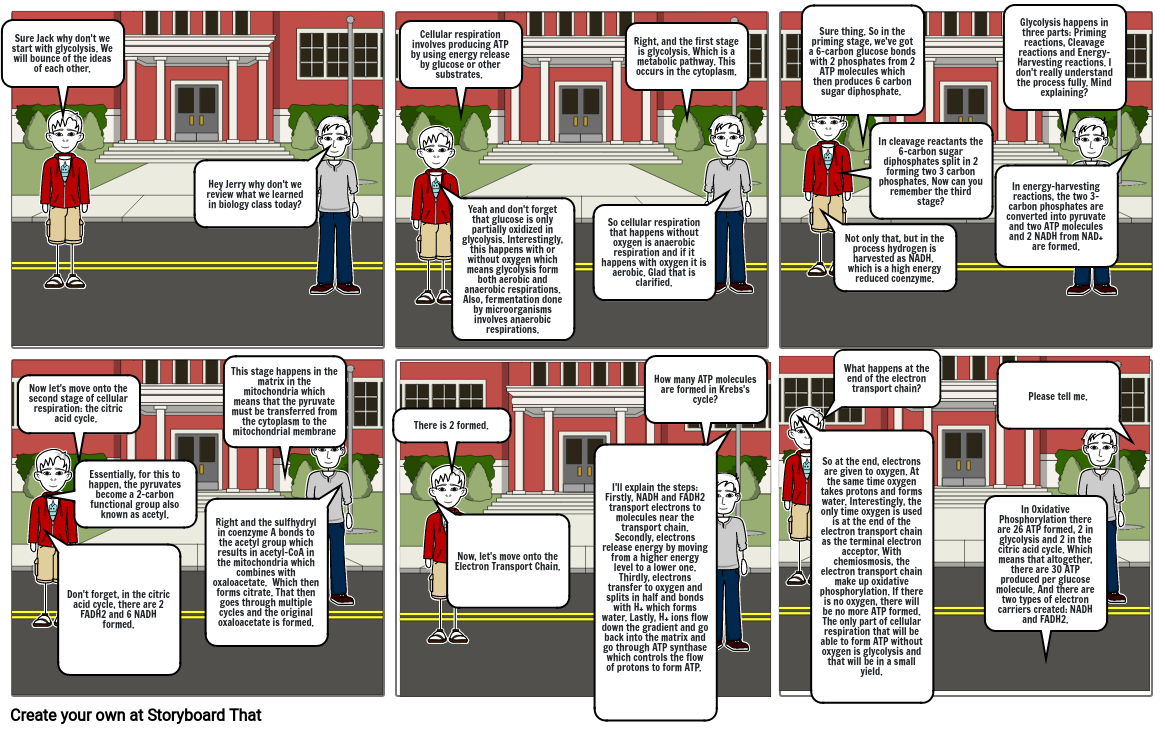Science

Storyboard Text
- Sure Jack why don't we start with glycolysis. We will bounce of the ideas of each other.
- Hey Jerry why don't we review what we learned in biology class today?
- Cellular respiration involves producing ATP by using energy release by glucose or other substrates.
- Yeah and don't forget that glucose is only partially oxidized in glycolysis. Interestingly, this happens with or without oxygen which means glycolysis form both aerobic and anaerobic respirations. Also, fermentation done by microorganisms involves anaerobic respirations.
- So cellular respiration that happens without oxygen is anaerobic respiration and if it happens with oxygen it is aerobic. Glad that is clarified.
- Right, and the first stage is glycolysis. Which is a metabolic pathway. This occurs in the cytoplasm.
- Sure thing. So in the priming stage, we've got a 6-carbon glucose bonds with 2 phosphates from 2 ATP molecules which then produces 6 carbon sugar diphosphate.
- Not only that, but in the process hydrogen is harvested as NADH. which is a high energy reduced coenzyme.
- In cleavage reactants the 6-carbon sugar diphosphates split in 2 forming two 3 carbon phosphates. Now can you remember the third stage?
- In energy-harvesting reactions, the two 3-carbon phosphates are converted into pyruvate and two ATP molecules and 2 NADH from NAD+ are formed.
- Glycolysis happens in three parts: Priming reactions, Cleavage reactions and Energy-Harvesting reactions. I don't really understand the process fully. Mind explaining?
- Now let's move onto the second stage of cellular respiration: the citric acid cycle.
- Essentially, for this to happen, the pyruvates become a 2-carbon functional group also known as acetyl.
- Don't forget, in the citric acid cycle, there are 2 FADH2 and 6 NADH formed.
- Right and the sulfhydryl in coenzyme A bonds to the acetyl group which results in acetyl-CoA in the mitochondria which combines with oxaloacetate. Which then forms citrate. That then goes through multiple cycles and the original oxaloacetate is formed.
- This stage happens in the matrix in the mitochondria which means that the pyruvate must be transferred from the cytoplasm to the mitochondrial membrane
- There is 2 formed.
- Now, let's move onto the Electron Transport Chain.
- I'll explain the steps:Firstly, NADH and FADH2 transport electrons to molecules near the transport chain. Secondly, electrons release energy by moving from a higher energy level to a lower one. Thirdly, electrons transfer to oxygen and splits in half and bonds with H+ which forms water. Lastly, H+ ions flow down the gradient and go back into the matrix and go through ATP synthase which controls the flow of protons to form ATP.
- How many ATP molecules are formed in Krebs's cycle?
- So at the end, electrons are given to oxygen. At the same time oxygen takes protons and forms water. Interestingly, the only time oxygen is used is at the end of the electron transport chain as the terminal electron acceptor. With chemiosmosis, the electron transport chain make up oxidative phosphorylation. If there is no oxygen, there will be no more ATP formed. The only part of cellular respiration that will be able to form ATP without oxygen is glycolysis and that will be in a small yield.
- What happens at the end of the electron transport chain?
- In Oxidative Phosphorylation there are 26 ATP formed, 2 in glycolysis and 2 in the citric acid cycle. Which means that altogether, there are 30 ATP produced per glucose molecule. And there are two types of electron carriers created: NADH and FADH2.
- Please tell me.
Over 30 Million Storyboards Created

